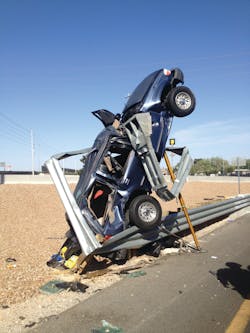Working as a public information officer (PIO) for the past 30-plus years, I have used a number of ways to get information out to the public, mostly through the media.
In the very early days, I would keep a roll of quarters in my pocket so I could stop to use pay phones to get the latest information out. Next came the cell phone, which made information dissemination even faster.
In the early 1990s, we moved to digital pagers for text messaging to members of the media who carried pagers. In the next decade, mobile computer terminals enabled me to send emails and disseminate media releases directly from incidents. Sometimes, I could also send photos, but that took a long time because of the large size of the images.
Now, a new tool lets me send out information immediately, while at the same time providing the same information to the public. That tool is social media. Relatively speaking, social media is still in its infancy, but is growing faster than any other communications method of the past.
Why is it different?
What makes social media different? First the information is being disseminated by the source. How many times have we listened or watch the news and said, “That’s not what I told them” or it was told in a different way than the way you wanted. Now you can deliver the message directly to your audience in your own words.
Social media also permits two-way communications. The recipients can ask questions or provide information back to you. They may provide information or sometimes even photos or video that you do not have access to.
The tools needed for social media is a communications device such as a smart phone, computer or tablet, plus the software or app for the various social media applications you use. For most of my social media work I use an iPad for a tablet. It has a variety of apps on it for my social media work such as maps, a camera, editing functions and various social media apps.
I also carry a separate Internet Hot Spot by one of the various cellular providers so I have communications (WiFi) capabilities while working on scene. If you do not have WiFi or cellular access while in the field, you will have to wait until you can get to a place that does to upload/send your information. I would suggest you use your own private WiFi hotspot that is password protected so no one can hack into your devices during an incident.
Here are some of the various social media apps I use that I find are extremely useful while performing my PIO duties:
• Twitter – I use Twitter for very short (140 character) messages. I can even attach photos to “tweets.” I tweet information about upcoming events, fire safety and incidents in progress. I use this app the most for information dissemination.
• Facebook – I use Facebook for department information, such as the daily activity report, media releases, photos, announcements, watches/warnings and other information as needed. I plan to expand the Facebook site with more interaction.
• YouTube – I shoot video with my iPad, edit it with an app and then upload it to YouTube. Once it is uploaded, you can create a post on Twitter or Facebook that your video is available for viewing. When the media didn’t respond to cover an incident, in nearly every case they used the video I posted to YouTube. Many times while I am still on scene, they will call and ask if I can shoot video and upload it. Remember, not only is the media using it, but people all over the world are looking at it.
• Instagram and Flickr – These are two photo depots I use to upload photos for people to view. The media can see it as well as the public.
Something to remember about using social media for PIO work is that once you release it, it is gone – there is no way to retrieve it. Make sure it is accurate and approved before dissemination.
I still issue media releases and use email, telephones, digital cameras and other tools for my work. Social media is just another tool for me to use and I have found it to be extremely useful. Now people don’t have to wait until 6 or 11 o’clock to watch it on the news. By using social media, they can get the news anytime, when it is happening and directly from the source.
TIMOTHY R. SZYMANSKI has been in the fire service for 41 years and is the Public Education & Information Officer (PEIO) for Las Vegas, NV, Fire & Rescue. He has worked in every position from firefighter/paramedic to fire chief. Szymanski is a Nevada-certified Fire Service Master Instructor and holds national and state certifications in many areas of the fire service. He has received numerous awards, including the 2008 Liberty Mutual National Firemark Award for Community Education and the Community Service Award from the Nevada Broadcasters Association. He was the Fire & Emergency PIO during the 1996 Olympics in Atlanta. His website is www.firepeio.com and Twitter at firepeio.






